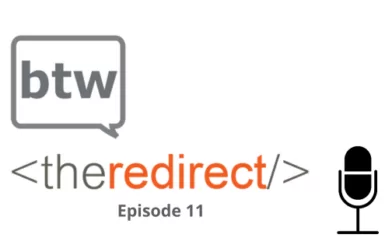Episode 16 / September 22, 2017
Listen Now:
In Episode 16 of The Redirect Podcast, the BlackTruck team explored how relationships contribute to local SEO, making HTTPS migration troubleshooting as straightforward as possible, and some common SEO mistakes made in blog posts. Read on for insights and takeaways:
Relationships that Build Local SEO
A recent article from Search Engine Watch summarized Greg Gifford’s recent presentation at Brighton SEO. He talked about the importance of inbound links for local SEO, even if they’re links from unrelated industries, and gave some ideas for local relationships that can result in gaining local links, such as groups or charities you support, teams or events you sponsor, connections to local press, business associations, etc. Of course, sticking with our ongoing theme of being human, it’s not about the link – it’s about the relationship. Building authentic relationships can involve offering value for the organization’s audience – maybe by contributing an article, teaching a workshop, or supporting an event – which could result in new links to your site.
This also brings up the concept of “linking C-blocks,” which essentially indicate variety in the geographical and topical sources of links to a site. While from a topical/contextual perspective it’s important to have relevant business associations and industry publications link to your site, from a local SEO perspective it is also good for a local nonprofit that may have nothing to do with your industry to link to your site.
Takeaway: If your business/org has a public relations team, help them identify any additional local opportunities, and work with them to secure links from any established relationships with local publics. If you don’t have a PR department, an SEO can help identify these opportunities/relationships and work to establish links.
Related to this topic, Britney Muller recently published a great resource on the Moz blog about prioritizing SEO tasks. In the article, she linked to a list of questions she asks every new client. I was struck by how much information the questionnaire gathered upfront that didn’t just address the client’s business goals, competitors, and target markets, but also things like current resources they have that may be link-worthy, any previous or current PR work, websites or publications they’d like to be featured in, and other forward-thinking questions that would inform link-building, content creation, and outreach efforts. With Greg’s presentation in mind, I would also add a question about existing community relationships.
HTTPS Migration Worries
It has been confirmed by Google that for those migrating to HTTPS, it can take up to 3 to 4 weeks of fluctuations before rankings stabilize. Given that Google has to re-index the entire site, depending on the size of the site and different elements changing, this is not surprising.
An HTTPS migration, while it should be considered, is also not a task that should be taken lightly. Jennifer Slegg at The SEM Post recently had the privilege of moderating a discussion with Google’s Gary Illyes at Brighton SEO. In that discussion, she asked him key questions around the topic of HTTPS.
Illyes went on to explain how they (Google) are working on stabilizing more of the factors that go into transitions to HTTPS, and if rankings do not stabilize, odds are you have a deeper issue that needs to be corrected.
The most interesting part of the discussion between Jen and Gary was that he encouraged people to not make other major structural changes during an HTTPS migration. The approach and thinking here is that it’s easier to debug any issue that could arise from an HTTPS migration. If you make too many other changes, like a major site redesign PLUS an HTTPS migration, you could be going down too many paths to be able to effectively correct the problems.
SEO Mistakes Blogs Make
You put in the effort to optimize all the pages on your site for that relaunch – now don’t drop the ball on best habits for your blog. Search Engine Land shares some common blog SEO “mistakes” with best practices to correct them. Many of these are part of an SEOs’ autopilot mode, but it never hurts to be reminded from time to time. Below is a quick summary of the points from that article:
Mistake #1: Unoptimized Keyword Structure
The site may be covering topics, but the keywords are still not on point, therefore not really acknowledging what users are demanding. You need to know the audience and what they are searching for that leads them to you. This can’t be accomplished with just thematic topics.
Mistake #2: Inconsistent Internal Links
Internal links should have great anchor text. Establish paths to your best content and show users how to navigate the site. Well-implemented internal links also allow crawlers to see what’s important to the site.
#3: Poor Page Copy
There are a lot of small steps you can take to build more effective copy and thereby keep your visitors interested. Leverage a powerful headline to lead to a great first paragraph. Add a nice transition into second paragraph to suck the readers in. Insert images, or maybe even GIFs, to help give mental breaks. Edit edit edit. Break up text with margins and spacing.
#4: Unoptimized Images & Video
We’ve discussed this one a lot. Clean the images up – formatting AND size. Keep them clean and sharp with great anchor text.
#5: Poor Content Promotion
Your work will never get visitors if it isn’t distributed or promoted through organic or paid efforts. Leverage your peers, friends, family, and associations in sharing what you’ve created. Get to know your audience through analysis and find what works. What gets actions and responses? Hone in on best practices for your specific industry and audience. Once you’ve gone through this analysis, you can also create additional relevant content around the insights you’ve gathered.
Thanks for tuning in! To catch future episodes of The Redirect Podcast, subscribe on Soundcloud, iTunes, or Stitcher.


